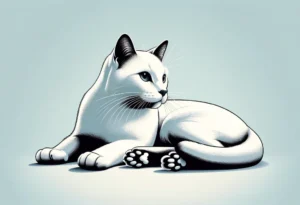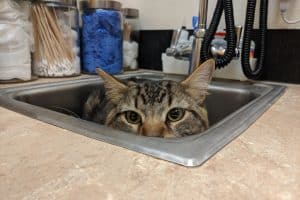Cats are known for many distinct features, and one of the most noticeable is their pointy ears. Have you ever wondered why cat ears are shaped the way they are? Let’s explore the fascinating reason behind this unique feline trait.
Evolutionary Purpose
The pointy shape of cat ears has evolved over time for a specific reason – survival. In the wild, cats rely heavily on their keen sense of hearing to detect prey, predators, and other potential dangers. The pointed ears of cats are designed to amplify and pinpoint even the faintest of sounds, giving them a distinct advantage in the wild over animals with less acute hearing.
Additionally, the upright positioning of cat ears allows them to rotate independently, enabling cats to accurately locate the source of a sound. This evolutionary trait helps cats not only hunt effectively but also evade threats by quickly identifying the direction of a potential danger.
Enhanced Hearing Abilities
Cat ears are uniquely shaped to provide them with superior hearing abilities compared to humans and many other animals. The pointed structure of their ears allows them to capture and funnel sound waves more effectively into their ear canal, amplifying even the slightest noises.
Moreover, the mobility and flexibility of cat ears enable them to pivot up to 180 degrees, further enhancing their auditory range. This advanced hearing ability not only serves cats well in hunting and navigating their environment but also helps them communicate with other cats through a wide range of vocalizations and subtle sounds.
Key insight: Cats’ hearing is so powerful that they can hear ultrasonic frequencies that are beyond the range of human hearing, allowing them to detect subtle movements and communicate over long distances. This unique ability has been crucial to the survival and success of cats as predators in the wild.
Communication Signals
Did you know that a cat’s pointy ears are not just a cute accessory? Cats actually use the position and movement of their ears to communicate with other cats and even with humans. When a cat’s ears are facing forward, it usually means they are feeling friendly and curious. On the other hand, ears flattened back against the head could signal fear or aggression. So next time you see a cat with its ears in a certain position, pay attention as it might be trying to tell you something!
Thermoregulation
It’s not just about looking adorable – the shape of a cat’s pointy ears serves a practical purpose too! Cats use their ears to regulate their body temperature and stay cool in hot environments. The thin and delicate skin of a cat’s ears is filled with blood vessels close to the surface, allowing for efficient heat exchange. This helps the cat dissipate excess heat and maintain a comfortable body temperature. So those cute little ears are actually working hard to keep your feline friend comfortable in the heat!
Additional Unique Insight: Cat Whiskers
In addition to their pointy ears, a cat’s whiskers also play a crucial role in their communication and sensory abilities. Whiskers are highly sensitive and help cats navigate their surroundings, detect changes in air currents, and even communicate with other cats. So next time you marvel at your cat’s whiskers, remember that they are not just for show – they are a vital tool in your furry friend’s daily life!
Protection and Defense
Cat ears aren’t just cute accessories – they serve an essential purpose in protecting and defending our feline friends. The pointy shape of cat ears actually helps them detect and localize sound more accurately. This heightened sense of hearing allows cats to pick up even the faintest of noises, helping them stay alert to potential dangers in their environment.
Additionally, the upright and pointy shape of cat ears can act as a visual deterrent to predators or threats. When a cat feels threatened, their ears will instinctively flatten against their head, making them appear smaller and less vulnerable. This defensive mechanism can help ward off potential attacks and keep our furry companions safe.
Interesting Facts
Now, let’s dive into some fascinating tidbits about cat ears that might surprise you! Did you know that a cat can rotate their ears 180 degrees to capture sounds from different directions? This incredible flexibility allows them to pinpoint the source of a sound with remarkable precision.
Another fun fact is that a cat’s ear shape can vary depending on their breed. Some cats have more rounded ears, while others, like the Scottish Fold, have adorable folded ears. Despite these differences, the basic function of protecting and enhancing their hearing remains the same for all cats.
To add to the charm, cat ears are also highly expressive. If you pay close attention, you can often tell your cat’s mood just by observing the position and movement of their ears. So next time you see your furry friend twitching their ears, take a moment to appreciate the fascinating versatility and importance of these adorable appendages.
Common Misconceptions
Cat ears are pointy not because they can hear better, like popular myths suggest. The pointy shape of their ears is actually an evolutionary adaptation that allows them to detect sounds and movements more accurately. Unlike humans, cats can rotate their ears up to 180 degrees, helping them pinpoint prey or potential threats with precision. So, it’s not about hearing better, but hearing smarter!
Health Considerations
Monitoring your cat’s ear health is crucial. Any changes in the shape or position of their ears could indicate potential health issues. For example, if you notice your cat’s ears drooping or tilting to the side, it could be a sign of ear infections, mites, or even injury. Regularly checking and cleaning your cat’s ears can help prevent these issues. Remember, healthy ears equal a happy cat.
- Tip: Use a specially formulated ear cleaning solution for cats to keep their ears clean and free from infections.
By paying attention to your cat’s ears, you can catch potential health issues early and ensure your feline friend stays happy and healthy.
Bonding Through Ear Care
Taking care of your cat’s ears is not just about hygiene; it’s a fantastic way to strengthen your bond with your feline friend. Regular ear cleaning can create a positive interaction between you and your cat, helping them feel more comfortable and loved. By gently cleaning their ears, you show your care and affection, which can improve their overall well-being and trust in you. Remember, a happy cat means a happy owner!
Adaptation in Domestic Cats
The pointy shape of cat ears has a fascinating evolutionary history. In the wild, the pointed ears of cats helped them detect the slightest sounds of prey or predators. Even though our domestic feline friends don’t hunt for their food anymore, this trait still serves a purpose in their daily lives. Cat ears can rotate up to 180 degrees, allowing them to pinpoint the source of sounds with remarkable accuracy, whether it’s the sound of a rustling mouse or the opening of a treat bag. This unique adaptation showcases how even in our homes, cats retain their natural instincts for survival.
- Unique Insight: Cats with pointed ears are more sensitive to high-pitched sounds, making them excellent hunters or playful pouncers, as they react swiftly to even the faintest noises in their environment. Remember this when trying to engage your cat in play or training sessions, using sound cues to capture their attention and stimulate their natural instincts. Keep playtime exciting and interactive for your furry friend by incorporating auditory cues that cater to their acute hearing abilities.
Cultural Significance
Cat ears have a significant cultural presence across different societies. In Japanese culture, cat ears are often associated with the concept of “kawaii,” or cuteness, and are a popular motif in anime, manga, and fashion. The iconic “nekomimi” (cat ear headbands) are a staple accessory in cosplay and have even become a fashion statement in streetwear.
In Western culture, cat ears are often linked to Halloween costumes, playful accessories, and the concept of “catgirl” characters in fiction. They are seen as a symbol of independence, agility, and mystery. The image of a cat with its pointy ears is commonly used to represent agility, curiosity, and cleverness in various forms of media and art.
Behavioral Observations
Observing a cat’s ears can provide valuable insights into their mood, emotions, and behavior. When a cat’s ears are forward-facing and slightly tilted, it indicates that they are alert and focused. If their ears are flattened against their head, it usually signifies fear, aggression, or submission. Purring or relaxed ears can indicate contentment, while rapid flicking or twitching of the ears may signal irritation or agitation.
By paying attention to your cat’s ear position and movements, you can better understand their feelings and intentions, strengthening the bond between you and your feline friend. Remember, cats communicate a lot through their ears, so next time you notice them perking up or flattening down, take a moment to assess their emotional state.
Additional Insight:
– Cats can rotate their ears 180 degrees, which helps them pinpoint the source of a sound accurately. This incredible hearing ability plays a crucial role in a cat’s survival instincts and hunting prowess.
External Link:
- To learn more about cat behavior and communication through their ears, check out the American Society for the Prevention of Cruelty to Animals (ASPCA) guide on interpreting feline body language: ASPCA Cat Behavior Guide
Alex, a passionate animal lover, has experience in training and understanding animal behavior. As a proud pet parent to two dogs and three cats, he founded AnimalReport.net to share insights from animal experts and expand his knowledge of the animal kingdom.









